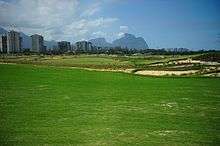Barra da Tijuca
| Barra da Tijuca | |
|---|---|
| district | |
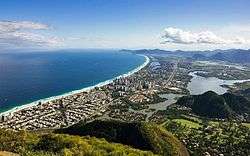 Panoramic view of Barra da Tijuca | |
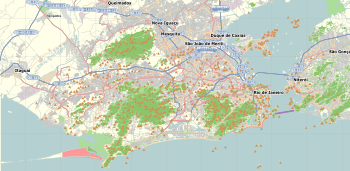 Barra da Tijuca Location in Rio de Janeiro  Barra da Tijuca Barra da Tijuca (Brazil) | |
| Coordinates: 22°59′58″S 43°21′57″W / 22.99944°S 43.36583°WCoordinates: 22°59′58″S 43°21′57″W / 22.99944°S 43.36583°W | |
| Country |
|
| State | Rio de Janeiro (RJ) |
| Municipality/City | Rio de Janeiro |
| Zone | West Zone |
Barra da Tijuca (Brazilian Portuguese: [ˈbaʀɐ dɐ tʃiˈʒukɐ]) (mostly referenced as Barra) is a neighborhood or bairro in the West Zone of Rio de Janeiro, Brazil, located in the western portion of the city on the Atlantic Ocean. Barra is well known for its beaches, its many lakes and rivers, and its lifestyle.
Although representing only 4.7% of the city population and 13% of the total area of Rio de Janeiro, Barra is responsible for 30% of all tax collected in the city. Barra da Tijuca is classified as one of the most developed places in Brazil, with one of the highest HDI (0.959) in the country, as measured in the 2000 Brazil Census. Differently from the South Zone and Rio's Downtown, Barra da Tijuca, built only 30 years ago, follows the Modernist standards, with large boulevards creating the major transit axis. A mix of modernity, sustainability and nature create the newest side of the city of Rio de Janeiro.
The area's masterplan was designed by Lúcio Costa, known for his work on Brasília, and creates a region filled with many gardens, shopping malls, apartment buildings and large mansions. In recent years, because of the development of the Brazilian economy, Barra has received more than 100,000 new residents and many companies' headquarters looking for a more modern address.
Those born in Barra da Tijuca, or those who live there, are called Barristas, Barrenses or, pejoratively, Barraíbas. The neighborhood of Barra da Tijuca is a cultural, economic, and administrative hub of the city, and is believed to be the safest of Rio's upper-class neighbourhoods because of its lack of favelas and plentiful private and public security. Barra da Tijuca neighborhood is well known for being the home of celebrities and soccer stars.
In August 2016, Barra hosted most of the venues of the 2016 Summer Olympics, the first held in South America.
Demographic data indicates that the region is the fastest growing county in Rio: 98,851 in 1991, 174,353 in 2000, and 300,823 in 2010.
Etymology
The name Barra da Tijuca can be roughly translated as 'Swamp Sandbank'. Barra means port entrance or sandbank, and Tijuca is a word originally from the Tupi ty-yúc and means putrid water, mud, swamp, puddle, clay or clay-pit.
History
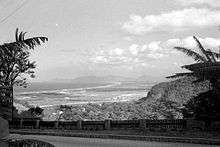
The region of Barra da Tijuca was originally a huge beach, with typical undergrowth sandbanks. The area, full of swamps and unsuitable for planting, remained unoccupied until the middle of the twentieth century, even though occasional groups of fishermen frequented the region.
In the year 1667, the region was given to religious Benedictines, who settled only in the neighborhoods of Camorim, Vargem Pequena, and Vargem Grande.
In 1900, the lands of Barra da Tijuca and Baixada Jacarepaguá were sold to the company Remedial Territorial Agricultural and SA, ESTA, which remains a large land owner in the area. The concentration of large tracts of land in the hands of a few was one of the causes of its late growth. Additionally it is separated from the rest of the municipality by large, difficult-to-cross mountain ranges with peaks ranging from 800–1200 meters.
Development of the area took place initially on its two ends, in current Jardim Oceânico and in Recreio dos Bandeirantes. A bridge was then built by private initiative over the Tijuca Lagoon to serve the area's new inhabitants.
The hallmark of the early development of Barra da Tijuca, however, occurred in the administration of Governor Negrão de Lima, the former governor of the state of Guanabara, who commissioned Lúcio Costa, one of the region's urban designers. The plan for Barra in 1969 was similar to the earlier one for Brasília. It was inspired by American urban planning style with wide boulevards and large open spaces, which definitely marked the beginning of the peculiar lifestyle of Barra.
In the 1970s the Lagoa–Barra Highway was built, which allowed a greater development since it reduced the time to go to the South Zone of the city of Rio. At that same time, big planned condominiums which inspired "the new way of life", how it is commonly called, were developed in Barra, such as the condominiums Nova Ipanema and Novo Leblon.
In the 1990s, another large urban development that enabled better connection with the North Zone of Rio was the creation of the Yellow Line, an expressway linking Barra da Tijuca to the Galeão International Airport. Since then, the growth of Barra da Tijuca has been characterized by large inflows of people from all parts of the metropolitan region of Rio de Janeiro looking for the "paradise city".
Barra City's Project
During the 1980s, Barra da Tijuca experienced a population explosion, with virtually all the land along its boulevards occupied by large residential condominiums, parks, supermarkets, shopping malls, schools and hospitals. The avenues were widened and received traffic lights. At this time there was a movement for the emancipation of Barra into a city, but while those who voted for emancipation in a referendum were the majority, they were not enough.
There is still a bill in progress in the Legislative Assembly of Rio de Janeiro for the formation of a new Barra da Tijuca council from the region's districts (Barra, Recreio, Grumari, Vargem Pequena, Vargem Grande, Itanhangá, Joá e Camorim). The project, however, depends on the approval of the Federal Congressional bill PEC 13/03, which transfers to the states the power to legislate on this matter, as it was until 1996.
Lifestyle


As the most recent region, built only about thirty years ago, Barra introduced a new concept of life in the country: a concept characterized by big luxury condominiums with an incredible leisure infrastructure (sports courts, pools, private groves and lakes, spas, gyms), all of that inside of the condominium for the use of its residents and guests. The "neighborhood-condos", as they were named, have the idea of creating an exclusive neighborhood for its residents, making it possible for them to live a complete life without the need to leave the condominium. Beyond the whole entertainment offered, the condos also have a high security system to ensure the privacy and safety of its residents. The residential areas of Barra are also known as being environmentally friendly.
The region is characterized by a car culture, and is crossed by three main routes: the Avenue of the America - "Avenida das Américas" (main road in the region; it is approximately 21 km long), "Avenida Ayrton Senna" (which connects the district of Barra and the Yellow Line, or 'Linha Amarela' highway) and "Avenida Lúcio Costa", formerly Sernambetiba Avenue, which follows the coastline.
Most famous local areas



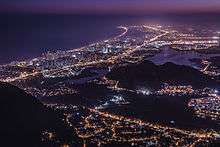
Jardim Oceânico
Jardim Oceânico (Ocean Garden, in Portuguese) is a sub-district of Barra da Tijuca. Predominantly formed by three-story buildings It is an area similar to the South Zone of Rio de Janeiro. As part of the preparations for the Rio 2016 Olympics, a subway station was opened in the neighborhood. The mainly residential area is also home to several bars and restaurants on the Olegario Maciel and Erico Verissimo streets.
Península
Península marked Rio's residential history. Designed by a real state company, the original project consisted in the creation of a new neighborhood being environmentally friendly. However, because of the unexpected fast appreciation of the site, the project for the Península Barra (former name) changed from being a neighborhood to a massive private urban development complex, making the Península (which has the same size of Leblon's neighborhood) the newest and first eco-friendly urban development complex in Rio de Janeiro. Located in the heart of Barra, right behind the Barra Shopping in an area surrounded by its own private lake (Península Bay) and a big leisure infrastructure, Península won the prize of the best urban development complex in Brazil. The complex which still has some towers under construction, will consist at its completion of: 62 residential towers, 2 business towers, a mini mall, 5 theme gardens and 2 big parks. Because of the huge success, the project became a parameter to many other urban developments in Barra. The real estate 'boom' in Rio right after the city was chosen for the 2016 Summer Olympic Games affected the prices in Península; researches show that the prices have increased up to 300%, making the square meter in Península one of the most expensive in the city of Rio de Janeiro. The complex, considered by the 'cariocas' as one of the best family urban developments in the city, is now one of the favorite places of the celebrities of Rede Globo.
Areas formed only by residential towers
- Alfa Barra
- Atlântico Sul
- Américas Park
- Barra Bali
- Barra Sul
- Barramares
- Blue
- Bosque Marapendi
- Cidade Jardim
- 5 Estrelas Full Condominium
- Golden Green
- Le Parc
- Mundo Novo
- Ocean Front
- Parque das Rosas
- Península
- RiO2
- Riserva Uno
- Riviera dei Fiori
- Barra Mais
- Villas da Barra
Areas formed by houses and residential towers
- Beton / Jardim Barra Linda - Houses | Mansions | Apartments
- Mandala - Mansions | Apartments
- Nova Barra
- Nova Ipanema - Mansions | Apartments
- Novo Leblon - Mansions | Apartments
- Pedra de Itaúna
- Santa Mônica
Areas formed by houses
- Alphaville; * Cristal Lake; * Interlagos de Itaúna; * Jardim Clube da Barra; * Malibú; * Mansões; * Portinho de Massarú; * Porto dos Cabritos; * Quintas do Rio; * Rio-Mar; * Santa Helena; * Wimblendom Park; * Village Marapendi; * Vivendas do Bosque; * Vivendas do Sol; * Laura do Marie; * Santa Bridgёt.
Education
Several universities have a campus in the district, including Universidade Estácio de Sá, Pontifícia Universidade Católica, Universidade Gama Filho, Universidade Veiga de Almeida, Centro Universitário IBMR-Laureate and Instituto Brasileiro de Mercado de Capitais.
The district also has some of the best private schools in the city.
Shopping malls
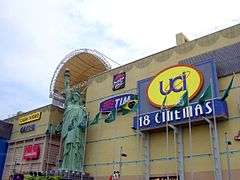

The neighborhood of Barra is home to many fancy, modern and mega-malls,the BarraShopping, the New York City Center, the Rio Design Barra and the 'Downtown' mall. There is still the Village Mall, the most exclusive and upscale shopping in Rio de Janeiro. List of the most important malls:
- BarraShopping (Avenue of the Americas)
- Village Mall (Avenue of the Americas)
- New York City Center (Avenue of the Americas)
- Rio Design (Avenue of the Americas)
- Downtown (Avenue of the Americas)
- Via Parque Shopping (Ayrton Senna Avenue)
- Cittá América (Avenue of the Americas)
- Casa Shopping (Ayrton Senna Avenue)
- Barra Square (Avenue of the Americas)
- Barra Garden (Avenue of the Americas)
- Barra Point (Armando Lombardi's Avenue)
- Barra World (Avenue of the Americas)

Gastronomy
Barra has not only architectural influences. The influence of the whole world, especially from Europe and Asia, can be easily found by the presence of restaurants of many different countries. The neighborhood has restaurants whose cuisines represent the countries of Italy, Japan, China, Portugal, Germany, Middle East, Australia, Finland, Austria, Spain, Mexico, France, India, Peru, Poland, Switzerland, Thailand, etc.
Transportation
There are 3 main avenues in Barra: Avenida das Américas (which connects almost the whole area of Barra), Avenida Ayrton Senna (former Avenida Alvorada, which connects Barra to Jacarepaguá neighbourhood) and Avenida Lúcio costa (former Avenida Sernambetiba, which passes alongside the beach). In all directions, the view includes lakes, mountains and the sea. The connection works of Barra with the rest of the urban network, transposing the Maciço da Tijuca (Lagoa-Barra highway and Via Amarela) are among the most expensive works already carried out in Rio, confirming the city's road transport choice. With a good transportation system, Barra, has many bus routes and in 2009, the Barra's subway line started to be built for the Rio Olympic Games in 2016. Barra have a BRT corridor and other two under construction that will connect Barra to the international airport, west region of Rio and Deodoro neighborhood, another main venue of 2016 Olympics.
Jacarepaguá Airport, an airport specialized in general aviation, is also located in the neighborhood.
Barra in sports
- The famous Brazilian Jiu-Jitsu academy Gracie Barra, takes its name and originated in Barra.
- The 2007 Pan American Games and 2016 Summer Olympics and Paralympics took place for the most part in Barra, the latter featuring 12 permanent and 3 temporary venues.
- The football (soccer) club Barra da Tijuca Futebol Clube derives its name from the region, and its headquarters are located in neighbouring Camorim.
- Three major Associations' headquarters are located in Barra da Tijuca: the Brazilian Football Confederation, the Brazilian Volleyball Confederation and Brazilian Olympic Committee.
- The Golden Green Golf Club provides three-par six-hole court greens open to outside players with illumination for night play. Itanhanga Golf Club is also nearby.
- Surf competitions, such as Rio Marathon Surf Internacional, Festival Petrobras de Surfe, Campeonato Velox Surf Amador and Circuito Petrobras are held in Barra. There are several surfing schools in the neighbourhood, an evidence of the popularity of this sport with the locals.
- The Aero Clube do Brasil provides parachuting experiences. The Rio Sport Center offers tennis courts to the public. Barrashopping and Barra Square are home to bowling alleys.
- There are several places where beach and court volleyball are practised. The Bernandinho's School is located in Barra.
- The numerous condos also offer several others sports courts exclusively for its residents.
The beach
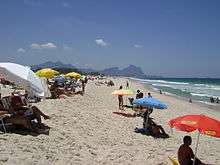

The 18 km long beach is the largest of Rio de Janeiro's beaches. Barra's beach starts at Morro do Joá and ends at the Recreio dos Bandeirantes neighborhood, in Pontal de Sernambetiba, beyond Avenida Lúcio Costa. Most of its waters are clear and green, and have an uncommon wave formation. Barra da Tijuca beach is one of the most sought after beaches by surfers, windsurfers, bodyboarders, kitesurfers and fishing enthusiasts. There is also a cycling lane along the beach. Pepê beach, closer do Morro do Joá, is where young sport practitioners meet. One can find Kite surf schools, natural food kiosks, surf schools, surf paddling and more. It is a crowded place at weekends. If one wants more privacy in Barra beach, the best spot is Reserva. It is located in the middle of the beach and there are not many places to park a car.
Curiosities
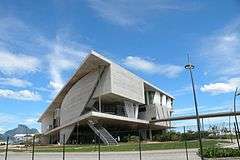
- Barra has the largest convention center in South America, Riocentro.
- Largest beach in Rio de Janeiro.
- The new Rio de Janeiro concert room named Cidade das Artes (Arts City) is located in Barra, inspired by the Cité de la Musique located at La Villette park, in Paris. The invited architect, Christian de Portzamparc, is the author of the original Cité de la Musique project. This music complex is the largest one in South America.
- About 20 shopping malls are located in the neighborhood, including the most upscale and most known of the city.
- The largest shopping center in South America is BarraShopping.
- The Rio Olympic Games in 2016 was mostly held in Barra, about 50% of the competitions.
- Almost 30% (US$250 million) of the total money collected by the municipal property tax in the city of Rio de Janeiro is from Barra (although the neighborhood only occupies 13% of the city's area).
- Since the announcement of Rio de Janeiro as the city of the 2016 Summer Olympic Games, the properties of Barra already had an appreciation of 30%. Until 2016, another appreciation of 70% is expected.
Criticism
The influence from different countries is criticized by many citizens from the older areas of Rio de Janeiro, especially concerning the 26.8 meters (88 feet) high replica of the Statue of Liberty in the New York City Center. Barra also has replicas of many international architectural icons like the Leaning Tower of Pisa, the Tower Bridge of London, and the Eiffel Tower of Paris (all found in the Barra World Shopping Center). While Rio's traditional neighborhoods recall Lisbon and other Portuguese cities, the atmosphere in Barra da Tijuca is more like that of North American cities like Miami or Los Angeles. While that sort of thing may be common in the rest of South America, it has not always been so in Brazil. Brazilian traditional high society has had an ambivalent attitude toward the United States. Although such influences from European countries are appreciated by the Brazilian traditional high society, to the "guardians" of the traditional values in Rio de Janeiro, similar blatant imitations of and homage to the United States (i.e., replica of the Statue of Liberty) in Barra come as an affront.
See also
References
- ↑ "Localização - Mapa." Escola Suíço-Brasileira Rio de Janeiro. Retrieved on March 8, 2016. "Rua Corrêa de Araújo, 81 | Barra da Tijuca - CEP: 22611-060 Estrada Sorimå, 400 | Barra da Tijuca - CEP: 22611-030 Rio de Janeiro - RJ Brasil"
- Much of the content of this article comes from the equivalent Portuguese-language Wikipedia article (retrieved August 19, 2005).
